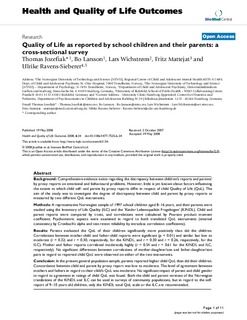Quality of Life as reported by school children and their parents: a cross-sectional survey
Journal article, Peer reviewed
Permanent lenke
http://hdl.handle.net/11250/2357634Utgivelsesdato
2008Metadata
Vis full innførselSammendrag
Background: Comprehensive evidence exists regarding the discrepancy between children's reports and parents'
by proxy reports on emotional and behavioural problems. However, little is yet known about factors influencing
the extent to which child self- and parent by proxy reports differ in respect of child Quality of Life (QoL). The
aim of the study was to investigate the degree of discrepancy between child and parent by proxy reports as
measured by two different QoL instruments.
Methods: A representative Norwegian sample of 1997 school children aged 8–16 years, and their parents were
studied using the Inventory of Life Quality (ILC) and the 'Kinder Lebensqualität Fragebogen' (KINDL). Child and
parent reports were compared by t-test, and correlations were calculated by Pearson product moment
coefficient. Psychometric aspects were examined in regard to both translated QoL instruments (internal
consistency by Cronbach's alpha and test-retest reliability by intraclass correlation coefficients).
Results: Parents evaluated the QoL of their children significantly more positively than did the children.
Correlations between mother-child and father-child reports were significant (p < 0.01) and similar but low to
moderate (r = 0.32; and r = 0.30, respectively, for the KINDL, and r = 0.30 and r = 0.26, respectively, for the
ILC). Mother and father reports correlated moderately highly (r = 0.54 and r = 0.61 for the KINDL and ILC,
respectively). No significant differences between correlations of mother-daughter/son and father-daughter/son
pairs in regard to reported child QoL were observed on either of the two instruments.
Conclusion: In the present general population sample, parents reported higher child QoL than did their children.
Concordance between child and parent by proxy report was low to moderate. The level of agreement between
mothers and fathers in regard to their child's QoL was moderate. No significant impact of parent and child gender
in regard to agreement in ratings of child QoL was found. Both the child and parent versions of the Norwegian
translations of the KINDL and ILC can be used in surveys of community populations, but in regard to the selfreport
of 9–10 years old children, only the KINDL total QoL scale or the ILC are recommended.
